What is watch lume? It’s a short form of luminous and basically means glow in the dark watches. There was a time in our childhood where mom bought a glow in the dark stickers. Now these stickers might be in the figure of a moon, stars or animals and you are happy seeing bright light coming from them.
That’s one type of lume, albeit the cheaper form compared to what is used in the watch industry. Watch lume is simply a watch that has been coated by a chemical substance (which we will delve on deeper down below) that give it an ability to glow in the dark.
Is Watch Lume Important To Have?
Yes of course! Then how do we tell time in dark? Electronic watches usually have a built-in backlight to illuminate the display. But how does we tell time in the dark with automatic or mechanical watches that don’t have battery?

An example of an electronic watch with built-in backlight
The answer is lume. Lume applied on the watch will help its wearer to tell time. This method has been used for decades, and while it isn’t that reliable (lume will die off after a few hours, unless its using radioactive material – more on that later on), that’s the best thing we have for analog non-electronic watches.
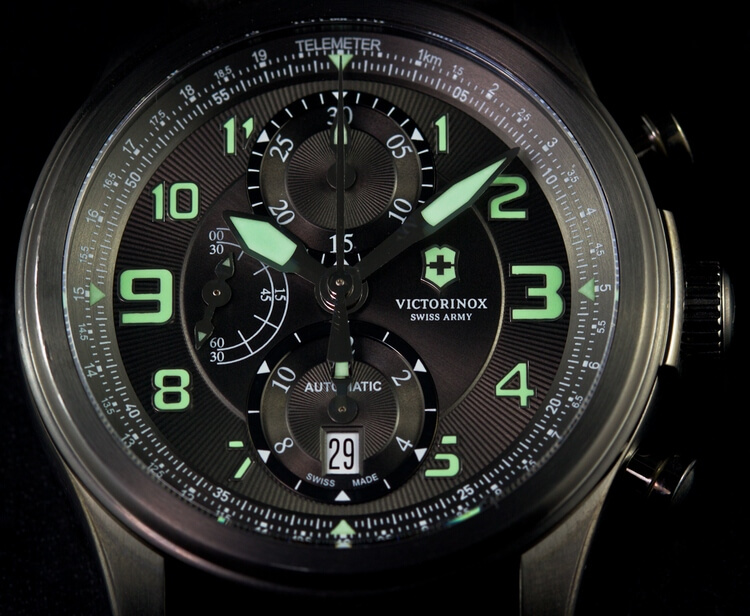 The bright green color of the numerals and hands are called lume. Shown above is the Victorinox Infantry Vintage automatic watch
The bright green color of the numerals and hands are called lume. Shown above is the Victorinox Infantry Vintage automatic watch
Lume has been used extensively on watches such as military watch, pilot watch, diver’s watch etc. where the ability to tell time in dark is very important.
Lume, Luminous, Luminescence
So what’s the difference between lume and luminous? I believe both are the same and they refer to luminescence which is a condition of emitting light without any heat source. The opposite of luminescence is incandescence, a way of emitting light that involves heat such as fire, etc.
The lights from fireflies can be categorized as bio-luminescence, a specific luminescence type that’s only present within biological creatures. In short, anything that produces light without burning or heating anything can be called lume/luminous!
History Of Lume
There are many ways that lume or fluorescent pigments are used in science and technology, you have glow in the dark tattoos and stickers. Well, thanks to the Chinese again, and it’s history and civilization because they are the one who discover luminous pigments that they applied to their paintings thousands of years ago which we modern people are enjoying with our watches today.
Imagine if this technology were not discovered, we might not be able to tell time in the dark or simply we need to put up a flash light just to see your time in your wristwatch. Now that we know the important of luminous pigment in our civilization, the Swiss wrist watch makers totally exploited this art and technology and applied mainly to analog watches.
The usage of watch lume watches in the visibility and telling time in the dark was so important especially in the military when they are conducting military operation in the dark desert or in the wilderness. Fast forward today, watch lume is a unique and attractive element for a watch that’s cherished by fans and owners.
Types Of Watch Lume
Basically, there are two ways a lume can be applied. The first one and the most common that is by applying lume substance on top of the hands (the needle showing time) and the markers (the numeral/index symbols showing 1-12 hours time). In the dark, the lume will shows the needle to tell time.
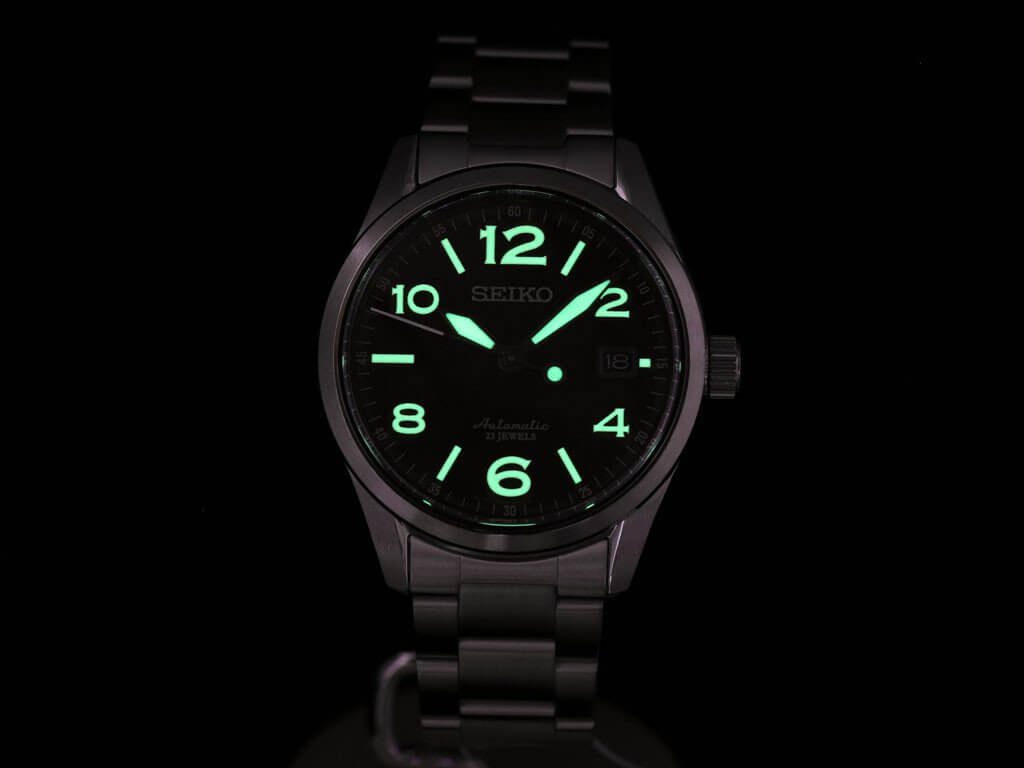 Above is the lume on Seiko SARG009
Above is the lume on Seiko SARG009
Another type of lume that’s a bit uncommon but more exquisite is the full lume on dial (or watch face). The lume material is luxuriously applied not just on the hands but also on the whole dial! This makes the whole watch face glows in the dark which is very very nice indeed =)
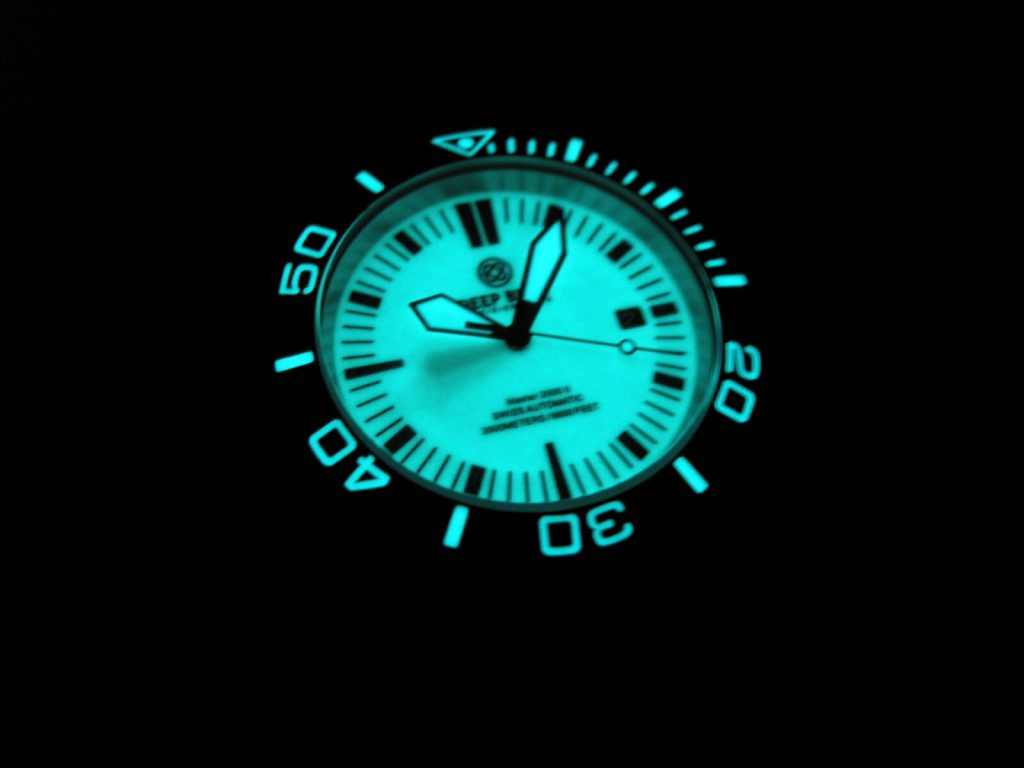 The Deep Blue Master 2000 II with beautiful light blue full lume on dial
The Deep Blue Master 2000 II with beautiful light blue full lume on dial
Watch Lume Paint Types
There are 3 types of lume paints: fluorescence, phosphorescence, or radioluminescence. Let’s see the difference between them!
1 – Fluorescence
The most common of them all is fluorescence. It’s widely used in many ways nowadays. Fluorescent material will emit light immediately after absorbing energy. By the way, fluorescent paints are not used in watches. Watches lumes only use the second and third type of lume paint (more on those below). But I thought it’s much better to give an overall picture of luminescence by elaborating a bit on this.
One example is fluorescent lamp which produces bright lights after being supplied by electricity. When the switch is on, the mercury (yes some lamps do have mercury, making them very dangerous if broken) inside the lamp will excite and emit short wave UV light that causes the fluorescent coating on the tube’s lining to glow brightly.
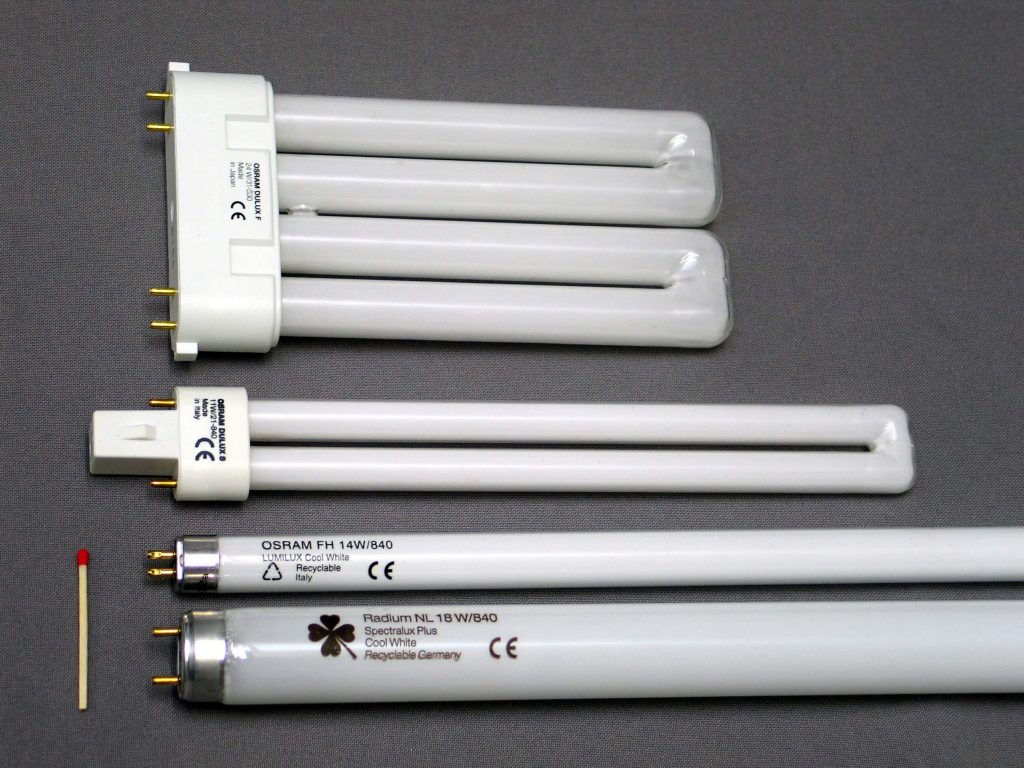 I’m sure you’ve seen at least one of these different types of fluoresecent lamps. All of them work based on the same concept: using fluoresent paints in the inner surface of the tubing to glow brightly
I’m sure you’ve seen at least one of these different types of fluoresecent lamps. All of them work based on the same concept: using fluoresent paints in the inner surface of the tubing to glow brightly
Another example of fluorescent effect is used in bank notes. Some countries bank notes have special markings put on them that’s only visible under UV light to deter any bank notes fraud. This is the same fluorescent effect that’s used in night vests, body ink paint and other usages.
2 – Phosphorescence
Phosphorescence is almost the same with fluorescence except that it will continue glowing after the excitation source ended. Taking the fluorescent lamp as an example, it will immediately die when electrical power is shut off – that’s a major element of fluorescence.
Phosphorescence on the other hand will continue to glow even when the energy source is taken off. Phospor, is any substance that emits phosphorescence. It’s not to be confused with phosphorus which is a chemical element.
Two of the most used luminous phosphorescent pigments are strontium aluminate and zinc sulphide with the former having a longer and brighter lume, thus more widely used in high performance lumes.
Lume on the Orient Ray II diver’s watch is an example of phosphorescence lume. The lume are normally green to light blue colors.
These substances will absorb energy in the form of UV light and where do you normally get UV rays? It what makes you look tan in summer, that’s right it is the sun. After the energy is cut off (i.e in the dark), the phosphorescence kicks in and the lume will grow brightly.
Aside from watchmaking, they are used also for avaitions markings, jewelry, emergency panels, silk-screen painting and many other usages due to its unique and very useful nature.
LumiBrite, Super-LumiNova, NoctiLumina
Nowadays, lume on consumer watches are restricted to only phosphorescence lumes due to its non-radioactive nature unlike radioluminescence (see below section). Among the lume paints used on watches, some brands are more widely known than others due to their higher than average performance.
Seiko’s LumiBrite, Super-LumiNova and NoctiLumina are some of the most famous brands. All of them have one thing in common, they are using strontium aluminate based phosphor substance.
Another thing in common? All of them can glow brightly in the dark for hours (up to 3-5 hours), assuming the lume is fully charged before hand. But as with any phosphorescent material, the lume will slowly die off at the end.
This is inevitable as we need to remember that these lumes only give back the energy (light) they absorb. Since there is a fixed amount of energy that they can absorb, there is a limited time duration that they can glow. The law of energy consevation still applies here (a little bit of physics here and there won’t hurt right lol).
So then, is there any types of lume that can glow continuously? Yes there is. Enter radioluminescence, the self-luminous substance.
3 – Radioluminescence
As the name imply, the source of energy for radioluminescence is radioactive materials combined with a luminescence substance (or phosphor). The radioactive materials will decay and emit energy which will then excite the phosphor to produce light without the need of any triggers or outside energy source.
The beauty of radioluminescence is it will glow much longer than normal phosphorescence lume. There are 2 most popular radioactive material used for watch lume: Radium and Tritium. Let’s look at both of them.
3.1 – Radium
The technique on applying lume on watches was practice in the early 1900 after the discovery of radium in the early 1800 and it’s the earliest type of watch lume used. Watch makers would then combine radium and with zinc sulfide and apply it to the hands and dials of the watch. The result is a bright glowing lume with very long luminous duration.
But radium, as a radioactive material can expose human to radiation causing myriad of health issues including cancer. Radium also can penetrate watch’s case and crystal, exposing the wearer to radiation.
Throughout the years of the harmful aspect of radium became better known to the consumer thus the amount of radium was reduced and by the year 1968, watch makers are forced to look for an alternative ways to lume their watches such as Tritium (see below) and phosphorescence.

An Ingersoll Radiolite vintage watch. Even though the lume on it does not work anymore, it’s still a radioactive source that needs to be specially handled
One more thing to note is that the combination of radium with zinc sulfide will cause the degradation of zinc sulfide, causing the lume to die off permanently. This is why vintage watches with radium as lume won’t glow anymore. But this does not mean the watch is free of radiation as radium is still on the dial . If you encounter such vintage watches, do be very carefull will ya!
Radium Girls – The Danger of Radioluminescence
A great example of the effect of radium radiationi due to watch making is the Radium Girls case. There was the case of women on the factory of United States Radium Corporation that filed a law suit to their employers for not telling them that the material (radium luminescence substance) they are applying to the hands and dial of the watch are harmful.
These factory worker would normally lick their paint brushes before painting the small markers, hands and dial of the watch. Some woman would also paint their finger nails and putting lume paint in their hair.

A look at one of the factories where young girls would apply radium lumes onto a watch face using paint brushes, without any protection whatsoever!
As a result they swallowed radium which lead to illnesses and some even died as the result of ingestion of radio-active lume paint. A trial was followed and was ruled in favour of the radium girls. This case is an example of how dangerous a radioactive material can be to humans.
3.2 – Tritium
Tritium was then introduced as an alternative to radium to be used as lume. It has many differences with radium. For a start, it has lower radioactivity than radium due to its nature. This enables it to be marketed as having negligible threat to humans (yeah right!).
It also is used in a different way than radium. While radium is used as a paint, tritium is a gas and enclosed in a small tube coated with phospor inside. Well, it’s kinda similar to how fluorescent lamp works. Tritium will then emit energy to that strike the phosphor coating and caused it to emit light.
Modern Mariner 6250 Series by Luminox that uses tritium lume tubes. The company promotes it’s self-powered illumination system and the so-called Luminox Light Technology – without mentioning those lumes contain tritium, a type of radioactive. Hmmm….
How To Charge Watch Lume
Since we already tackled and learn how luminous watch works and their components as well there source of energy, let us find out how charge luminous watch. How long does it take to charge lume? And how long does it last?
It is no brainer that phosphorescence lume watch get its energy source from light and the best way to charge is direct sunlight light. If you are working at night and there is no sunlight available then you can use an alternative, most people uses UV lamps or UV flashlight.
A normal sunlight is good enough to charge your lume for about ten to fifteen minutes and if you are using a UV lamps make it for about 30 minutes and you are good to go.
Now regarding how long does a lume last is based on the type of luminous watch you are using, normally it should last and readable for 1 to 2 hours with little charge on it. It also depends on the lume application area. Big lume areas will glow brighter and longer versus small lume areas.
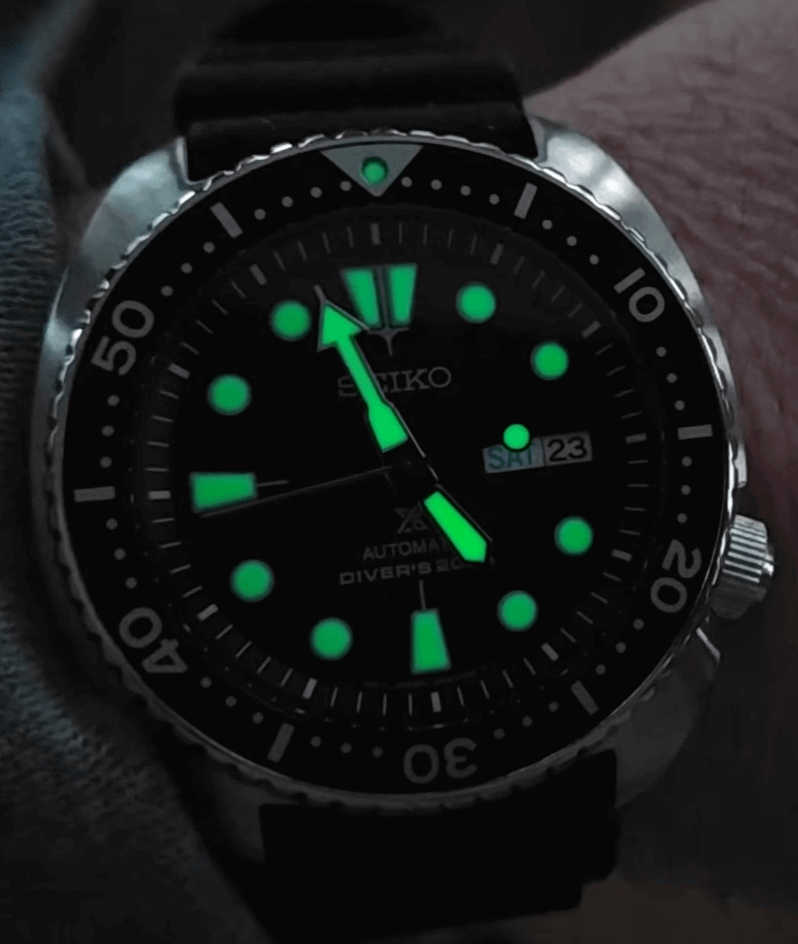 A lume shot of Seiko SRP777 “Turtle”
A lume shot of Seiko SRP777 “Turtle”
Conclusion
Having a watch lume is a good investment if you want to purchase an analog or an automatic watch. I know there are alternative watch that doesn’t need luminous materials like your digital or smart watch. However, analog watches that have lume on it will not go out of fashion and will still be treasured compared to an electronic watch.
Imagine having an automatic watch that is crafted beautifully and created with luminous material on it that shines brightly in the dark. Either phosphorescent or radioluminescence, the choice is up to you. Personally, I’d go for the non-hazardous lumes, but if you feel that a tritium tube lumes will serve you better (for those in the navy, army, etc.), then go for it. Just make sure to take extra precaution though.
So what are you waiting for? Don’t just sit and read this article, go on and buy your own luminous watch =)
***************************
Hope you guys learnt something about what is watch lume, types of watch lume, how to charge, etc. If there is anything missing in this article that you want to know, drop your comments below and I’ll get back to you. Share this article on your social media if you like it. It’ll really help me =)
Don’t forget to subscribe to my site for more awesome stuffs in future. Till next time.
Cheers!
Isaac



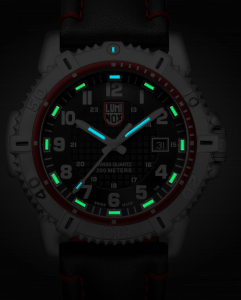
Tritium lume. Hmm Hydrogen bomb on a wrist. LOL! Seriously, any radioactive substance must be taken with great care. Any radiation poses a danger. Say you are a watch maker or a hobbyist doing your own customization or servicing, Radium dust could be inhaled (vintage watches) or extreme unlucky, tritium vile might break due to a one in a million break.
Me thinks you are better off with any watch using the post radium non radioactive lumes available: lumibrite, superluminova, etc. But if you do not mind the risks or are very careful then you may purchase, wear, collect the watch of your choice.
I still want to know what ume Hamilton uses as it does not last very long.
Robert is completely correct, beta particles cannot pass through the borosilicate glass tube so there is no radioactive exposure at all and hence no danger. Being conservative or not has nothing to do with it, it’s science!
Have you ever flown on a transatlantic flight? You’ll get more radioactive exposure doing that than from taking a visit to Chernobyl.
I have a Reactor .. https://reactorwatch.com/product-category/mens/ … Never Dark® is the first technology to combine the intense brightness of Superluminova with the multi-year longevity of tritium, providing optimal illumination under all lighting conditions.
Tritium is radioactive. Should You be worried?
Unlike radioactive isotopes that have been used on watches in the past, tritium poses no health risk to the wearer or to the workers who assemble the watches. Tritium’s radioactive decay produces only weak beta particles that are contained completely within the sealed glass tubes. Even if exposed, the beta particles do not posess enough energy to penetrate the outer layer of human skin.
Is this the best self bright watch on the market?
Hi Robert. The Reactor watches looks very interesting. A superluminova with tritium tubes will make the lume glowing all the time!
I guess it depends on the people. Some people are okay with it while others are more conservative and don’t want to put themselves to danger.
Cheers!